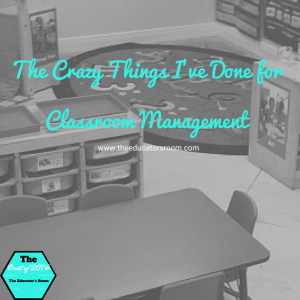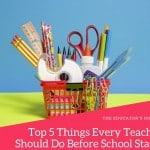 Some days it feels like we are running a zoo. I find myself saying things like, “Well, you can tell the weather is going to change. The kids sure were off the wall today.” Sometimes sentences escape my mouth that I never imagined would be created. Every teacher, from novice to seasoned, needs a little creative classroom management in their classroom now and then.
Some days it feels like we are running a zoo. I find myself saying things like, “Well, you can tell the weather is going to change. The kids sure were off the wall today.” Sometimes sentences escape my mouth that I never imagined would be created. Every teacher, from novice to seasoned, needs a little creative classroom management in their classroom now and then.
The most important foundation in a productive classroom is clear expectations along with a supportive, respectful, and safe environment. It is vital to set the stage in the beginning of the year (or the beginning of a semester for term classes). All too often, the classroom is chaotic because the teacher is not prepared. Students are left to their own devices and they behave like children. The time spent discussing your classroom expectations and procedures with students will pay off tenfold when they understand your goals and rules. It is imperative to practice these routines and continue to state your expectations; model and explain every behavior from how and when to sharpen pencils to what lining up and transitioning in the hallway should look like. There are times in the year, however, you may need a creative fix. Here are some of the crazy ideas I have tried over my sixteen years of teaching.
Take A Medal—with classroom sizes growing it is important to recognize positive classroom behavior. This year we had a superhero theme, but this could work with medals, beads, or any other type of necklace. When I catch students helping in our classroom (having supplies ready, working hard, helping a peer, trying something new) then they get to take a lightning bolt. These are foam cut outs on a piece of yarn. When I notice a positive behavior I want others to follow, I simply say, “Thank you for ___, Noah. You may take a lightning bolt.” These are returned at the end of the day so the supply pile does not run out. I try to catch my challenging students being good to keep them on the right track for the day. This is positive encouragement for others and recognizes those students with positive classroom behavior.
Commercial Break—this strategy is designed for your talkative class. Those groups of students who chat, visit, discuss, and never seem to stop talking long enough to do their work. Back before the digital age over took classrooms, I used a piece of foam board and drew a TV on the front. It had a power button, channel knob, and (most importantly) volume control. I took a picture of the class engaged in work, enlarged it and glued it to the board. On the flip side of the board I drew the same TV. Then I wrote the words “Commercial Break”. I discussed with the students what I expected for work time and then said when they were on task — working, quiet, engaged — we would take a commercial break. What do you do at home during the commercial? (Remember, this was before DVR and skipping commercials.) You get up, grab a snack, go to the bathroom, or visit. During the two minute commercial break students were allowed to chat about anything (school appropriate), so they could get their social fix. Then after two minutes I returned the TV to work time and they got back on task. When using this I started with a short work time with frequent commercial breaks. As the students were engaged I lengthened the work time. Eventually, most days, they would work for the majority of the time and the commercial break became our transition period.
Partner Up—with our superhero theme this year I started our Partners in Crime management strategy. This may not be a popular saying, so I changed it for the post. I strategically placed students in pairs based on academic or behavior needs. For the student who never knows the directions, they are paired with the student who could take over if I was called away. For the student who reads slowly, they were paired with a student who loves to read aloud. When we are working on a new concept, the students are to get with their partner in crime. If they have a question about the assignment or directions, they are to ask the partner in crime before asking me. This has worked to help students become independent in their work habits and encourages helpful behavior in the classroom.
Volume Control—this low tech method requires a remote control, either functioning or nonfunctioning. I explained my expected volume level to students and practiced appropriate levels. Then I used the remote as a visual clue for student to decrease their noise level.
Teacher Bear—most elementary rooms have those little plastic counter bears. You can use them (or any other character you want) for this management strategy. Each day, start with a note to a student with a positive behavior from the day before. “Cara, I like the way you always come to the carpet ready to learn.” Students then get to select a small plastic bear to sit on their desk all day to watch them work. If you want to be sure everyone gets a bear be sure to keep track in your grade book. The ornery kids just beam when you catch them being good.
Take a Number—we use group work constantly in the classroom. Be prepared for this with a large number on or above groups of desks. This can be used for collecting homework, getting supplies, etc. I also assign my students a classroom number and use that to call groups: even numbers, odd numbers, multiples of 5. When you need to quickly assign groups or have supplies picked up or taken out, this is a great management tool.
Coffee Anyone?—Organization is a key component to classroom management. We want students working on the task for the day, not taking time to pick up supplies and fight over supplies! Get large coffee cans (or have food service save you their veggie/fruit cans) and spray-paint them in your school colors. For elementary classrooms I would make each can a different color. Be sure to create enough for each group to have one. A classroom of 30 would need 10 cans if you use groups of three or larger. If you want them for partner work you would need 15. Also, put a HUGE number on each can to correspond with a table number. Put all supplies for the activity in the cans from handouts to art supplies, etc. This decreases the time students spend gathering and increases the time on the learning task.
Pick 3—another strategy for keeping your sanity is to have “Pick 3 before me!” rule. With this rule students need to ask three other students to help before they ask you. If they find three students who do not know the directions or cannot help with the concept, then you need to re-explain. This works best with middle school and above.
Pick Up Sticks—struggle with getting papers handed in or students not finishing work? Here you can assign each student a clothespin and have them clip their work to hand it in. I put their classroom number on the clip. This way I can quickly see who has not handed things in and also check the clips of my frequent non-finishers. This strategy saves time on paper searching and helps students develop responsibility for their work.
Finally! Include the students. Ask them how they would remember or what would be helpful. Practice and reteach your expectations when classroom management seems to be getting out of hand. Remember that kids will be kids and everyone has a bad day. Don’t be afraid to stop a lesson and regroup. Often times the error we make as teachers is establishing, but not requiring, our classroom management strategies of the students. Find what works for you and then explain, implement, practice, and re-explain. Use the tricks from above, nothing profound…just some common sense and creativity.




Lori, I loved this article! It has given me many great ideas to use in my own classroom. Thank you!
Great ideas and suggestions. One of the things we often forget as teachers that kids are going to be kids. They need those breaks from work to decompress….just like adults did. That is why things like the commercial break are so effective. Students know their hard is going to pay off in more than one way.
Thanks for sharing!